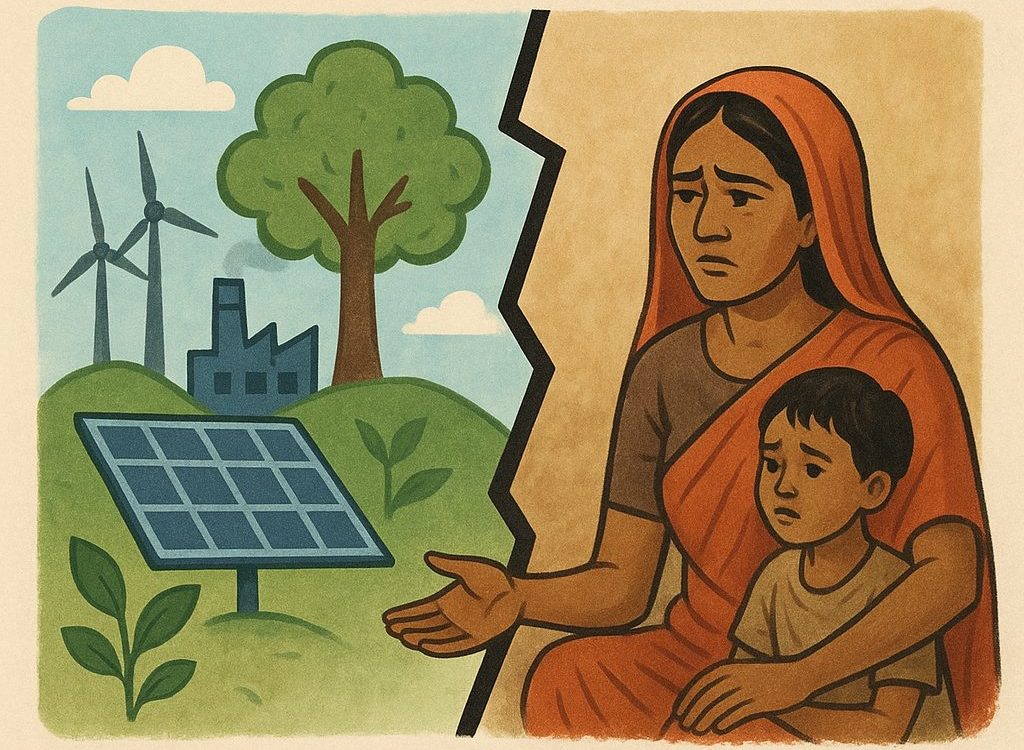| Smash 2025 FLT 09 Q18. Discuss how poverty acts both as a driver and a consequence of environmental decline in India. How can policy interventions disrupt this cycle? |
| PYQ Q. COVID-19 pandemic accelerated class inequalities and poverty in India. Comment. (2020) |
Sustainable development aims to balance economic growth, social justice, and environmental protection. However, in a developing country like India, where 228.9 million people still live in poverty (NITI Aayog, 2023 MPI Report), there is often a tension between protecting the environment and meeting the survival needs of the poor.
Sustainable Growth
- Inclusive Development – Balancing GDP growth with reduction in poverty and inequality.
- Green Energy Expansion – Scaling renewables energy (500 GW target by 2030).
- Sustainable Agriculture – Crop diversification, organic farming, millets promotion
- Green Jobs & Skills – Workforce transition towards solar, EVs, waste management.
- Resource Efficiency – Circular economy, recycling, sustainable mining and industry.
- Digital & Smart Infrastructure – Smart cities, e-mobility, resilient transport.
Environmental Protection
- Pollution Control – Enforcing emission standards, waste management rules.
- Climate Action – Low-carbon pathways, adaptation, and resilience (Net Zero 2070).
- Biodiversity Conservation – Biodiversity Conservation Act, Environment Protection Act
- Water & Soil Conservation – Watershed management, rainwater harvesting, anti-desertification efforts.
- Environmental Regulations – EIA, green clearance norms, NGT
- Community Participation – Joint Forest Management, people’s biodiversity registers.
Conflict Between Sustainable Growth, Environmental Protection, and Poor People’s Needs
- Dependence on Forests & Commons – Environmental protection restricts access to forests, rivers, and grazing lands. Eg– Tribal and forest-dwelling communities face eviction under wildlife sanctuaries and tiger reserves.
- Energy Access vs Green Transition – Shift from coal/wood to renewables raises costs for the poor in the short run as rural poor still depend on biomass. Eg- refilling costs under Ujjwala Yojana.
- Employment vs Environmental Norms – Stricter EIA and green clearances delay projects that could generate jobs. Eg– Mining bans in Goa and Bellary impacting informal workers.
- Pollution control vs Job creation – Eg- Vedanta’s Niyamgiri bauxite project (Odisha) scrapped for ecological reasons, blocking potential jobs for locals
- Livelihoods in Informal Sector – Eg– Ban on single-use plastics hit informal recycling workers and street vendors.
- Climate-Smart Agriculture vs Cost Burden – Eg- Organic/natural farming reduces chemicals but increases labour and costs for marginal farmers.
- Cost of Green Alternatives – Eco-friendly housing, EVs, organic food are often unaffordable for low-income groups. Eg– High cost of EV auto-rickshaws.
- Displacement by “Green” Projects – Large-scale renewable projects, dams, and afforestation drives can displace marginal communities. Eg- Sardar Sarovar Dam, Tehri Dam displaced 100,000 people
However, focus on Sustainable Development & Environmental Protection also Fulfils Poor People’s Needs
- Securing Livelihoods from Natural Resources – Eg– Joint Forest Management (JFM) in Madhya Pradesh increased forest cover while enhancing tribal incomes from tendu leaves and bamboo.
- Health Benefits for the Poor – Eg– National Clean Air Programme (NCAP) in Delhi reduced PM2.5 levels, benefitting vulnerable communities most exposed to air pollution.
- Affordable Clean Energy – Eg– Pradhan Mantri Ujjwala Yojana provided over 9 crore LPG connections, reducing indoor air pollution deaths (mostly among poor women).
- Resilience Against Climate Shocks – Eg– MGNREGA-linked watershed projects in Bundelkhand improved groundwater and farm incomes.
- Green Jobs and Inclusive Growth – Eg– Solar PV sector employed ~319,000 workers in 2023; total RE jobs ~1.02 million.
- Food Security through Sustainable Agriculture – Eg– International Year of Millets (2023) promoted climate-resilient crops consumed largely by rural poor.
- Rights-Based Environmental Protection – FRA 2006 and biodiversity laws empower poor communities with resource rights. Eg- rights over minor forest produce
Way Forward
- Inclusive Green Growth – Link poverty alleviation with sustainability through green jobs in renewable energy, waste management, eco-tourism.
- Just Transition Framework – Reskill workers from polluting industries (mining, coal) for jobs in clean energy and sustainable infrastructure.
- Integrated Rural Development – Use MGNREGA, watershed management, afforestation programmes to restore ecosystems while generating rural incomes.
- Strengthened Social Safety Nets – Housing, PDS, and health schemes must cushion vulnerable communities during green transitions.
- Policy Convergence – Align poverty eradication with SDG-1 (No Poverty), environmental goals with SDG-13 (Climate Action), and growth with SDG-8 (Decent Work and Economic Growth).
As Indira Gandhi reminded the 1972 Stockholm Conference: “Poverty is the greatest polluter.” Sustainable development in India must therefore mean ending poverty while protecting the environment.


